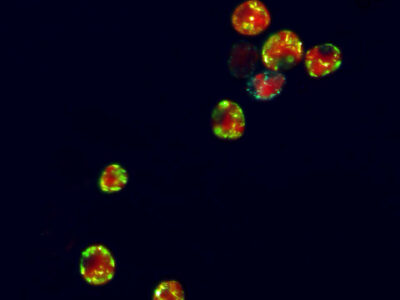
Greetings from the center of that eddy I mentioned in my last post! We’ve been here for five days so far, but tomorrow we are finally moving on. As far as eddies go, this is a tiny one, only 15 kilometers, but larger eddies can be 100 to 200 kilometers in diameter. The eddy we’re in is anticyclonic, which means it has a warm water core and rotates counterclockwise, albeit imperceptibly from my point of view on the deck of L’Atalante. Here in the center, the water seems smooth as a pond.
The physical oceanographers on board were excited about studying the turbulence throughout the water column here in the eddy center. I share in their excitement because studies have shown that Trichodesmium abundance is correlated with anticyclonic eddies.
Cruising toward the eddy, I pictured a swirling stew of Trichodesmium, an ephemeral phenomenon that would dissipate, sweeping away clues about how these transient physical features influence microbial physiology and biogeochemistry. We found a ton of Tricho out here, but it wasn’t necessarily soupy until today. At some point between this morning when Andi and I went out with the net tow and this afternoon, the surface water around us became dense with mats of Trichodesmium.
As the ship maneuvered to maintain position, the bow sliced through the mats, sending tendrils of green curling away in our wake. I watched the green swirl with the blue water and pondered what all that Tricho was doing up at the surface. It’s inhospitable for any organism floating out there in the direct sunlight. I can attest to this: the five minutes I stood on the deck taking pictures of the Trichodesmium were enough to give me a sunburn.
I’ve heard that floating mats of Trichodesmium is the sign of a crashed bloom. So, what changed suddenly changed? Some limiting nutrient could have been depleted to critically low levels, or a virus could have decimated the Trichodesmium population around us. Or the physics of the eddy could have forced the colonies to the surface. Whatever happened, it likely altered the physiology of the Trichodesmium, and consequently the environment.

Retreating back into the shade, I realized that our time in the eddy could encompass a narrative of a Trichodesmium bloom. Each day I’ve taken in situ samples of Trichodesmium, meticulously cleaned the colonies of any stowaway microbes. Back in the Dyhrman Lab at Lamont-Doherty Earth Observatory, I will extract the RNA from these samples and look at how gene expression of Trichodesmium changed over the course of our stay in this eddy. Hopefully this will help get a step me closer towards answering the questions above.
Now, however, with the day’s experiments finished, samples safely stored and bottles washed, I’m looking forward to a mini break from 24/7 science as we steam to the next station. As I was frantically running up to the incubators to harvest the last experiment, I noticed the crew building something on the front deck of the ship. Later, I enquired about this mystery project: it’s a hot tub.
Au revoir from 19 degrees south, 164 degrees east!
Follow @kylefrischkorn and the @DyhrmanLab on Twitter for more frequent updates from the OUTPACE cruise.



